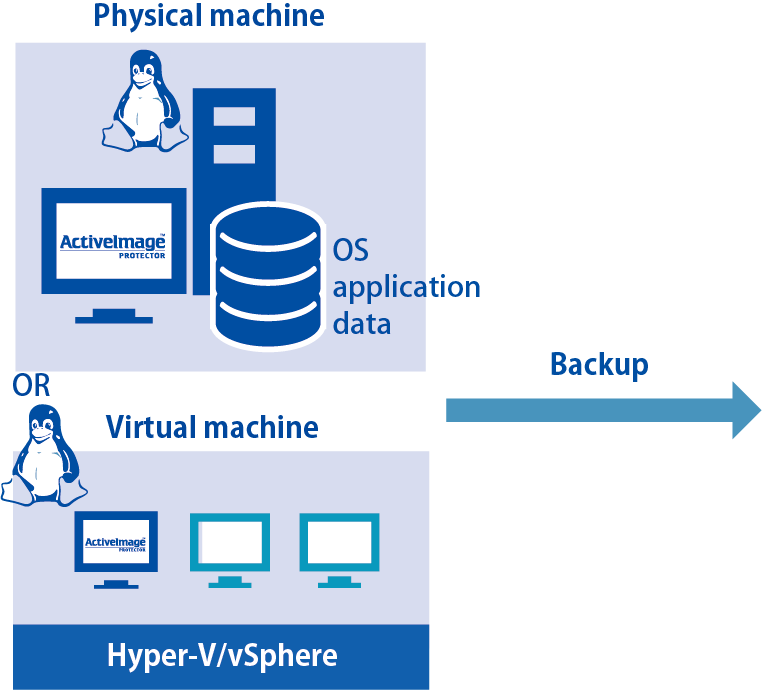- Home
- Product Introduction
- Linux
Summary
What is ActiveImage Protector™ ?
ActiveImage Protector is an enterprise-level backup and disaster recovery solution that supports both physical and virtual (Hyper-V/VMware), Windows/Linux, On-Premise/Cloud environments. ActiveImage Protector is the fastest and most powerful data protection solutions on the market, and provides all the necessary tools for enterprise deployment and management, immediate system recovery, switch-over availability, and virtual migration.
 |
Image file based backup (supports LVM) ActiveImage Protector™ backs up your entire machine, including the OS, settings, data files and applications, and access rights into a single image file. When disaster strikes, select a backup image to quickly restore for a fast and complete recovery. Linux edition supports backing up and restoring LVM volumes. |
 |
Direct-To-Cloud Backup Backup systems directly to cloud storage. Supported public cloud storage services include Amazon S3 and Azure as backup destinations. In addition, Direct-To-Cloud Backup also supports SFTP servers as backup destinations. |
 |
Ensure full-state recovery ActiveImage Protector™ backs up your entire hard disk including the operating system in a single operation. In the event of a hardware failure, the system can be restored to a different physical machine or a virtual machine. |
|
|
Faster and smaller backup with Smart Sector™ technology ActiveImage Protector™’s Smart Sector™ technology only backs up the used sectors on a disk, resulting in faster backup and smaller backup files. |
 |
Save storage space with IDDC Our Inline Data Deduplication Compression (IDDC) feature eliminates duplicate data while simultaneously compressing it, resulting in a significant reduction in backup storage requirements. An included advanced option, IDDC has no impact on backup processing time. No additional deduplication hardware or software purchase is necessary. |
 |
Fast Incremental Backups ActiveImage Protector™ includes a self developed change tracking driver that enables us to track the changes that occur on a volume incremental backups. Fast and efficient incremental backup includes only sectors that have changed from the last backuping saving you both process time and storage space. |
 |
Live Backup of MySQL, Oracle database and KVM on Linux ActiveImage Protector™ offers image-based backup of live MySQL, Oracle and KVM without needing to suspend database ensure the data in the backup is consistent. |
 |
Cross platform Linux/Windows GUI A cross platform graphical user interface that supports both Windows and Linux (X Windows) platforms. The GUI provides simple and easy access to ActiveImage Protector™ʼs features and settings across both platforms. CUI/CLI are supported. |
 |
Linux Based Recovery Environment Perform a disaster recovery quickly and run cold back-ups with ActiveImage Protector’s Linux based boot environment (LinuxBE) on DVD or USB media. The LinuxBE is built on Debian to recognize the latest devices for use in recovery on dissimilar hardware. |
 |
Boot Backup Images Instantly using HyperBoot™ Using our real-time virtual conversion technology, HyperBoot bypasses the lengthy, resource intensive, and cumbersome physical to virtual conversion process, and boots the backup as a virtual machine in minimal time. Changes made while running the virtual machine from a backup are saved as differential files. A proverbial “Spare Wheel” for recovery, migration testing, repair, or upgrading prior to actual deployment. |
 |
Additional Linux Distributions Support ActiveImage Protector Linux now supports Ubuntu 18.04 LTS and 20.04 LTS, Debian 9/10/11, RedHat 8.4, Rocky Linux 8, Alma Linux 8 and Amazon Linux 2. |
 |
Offline Environment Activation Support With Actiphy Authentication Service (AAS) or a license file, ActiveImage Protector agents can be activated in an off-line environment. |
License
ActiveImage Protector™ Linux
1 license is required to back up one physical or virtual Windows 10, 11 series environment.

System Requirements
Hardware
CPU:
Pentium 4 or above
Main Memory:
2GB or above. 3GB is recommended for “RescureBoot”.
2GB or more of available hard disk space is required at setup.
- 7 GB or more of available hard disk space is required for building AIP Boot Environment.
- 512 MB or more of available hard disk space is required when Boot Environment is not included.
- To run backup tasks using the Deduplication Compression feature, reserving 1% or more of the total data of the backup source for saving the temporary working files in a volume that should not be included in the backup source is required.
DVD-ROM Drive:
Required to install the product and boot up the ActiveImage Protector Boot Environment.
- ActiveImage Protector Linux Edition supports only x86_64 architecture
- Secure Boot is not supported.
Internet:
Internet connection is required
Operating System
Red Hat Enterprise Linux:
8.0 – 8.4 / 7.0 – 7.9 / 6.0 – 6.10(x86_64)
CentOS:
8.1 – 8.4 / 7.0 – 7.9 / 6.0 – 6.10(x86_64)
Oracle Linux:
8.1 – 8.4 / 7.0 – 7.9 / 6.0 – 6.10(x86_64)
AlmaLinux 8.3 – 8.4
Rocky Linux 8.3 – 8.4
Amazon Linux 2
SUSE Linux Enterprise Server 15 / Desktop 15
LVM configuration is not supported
openSUSE Leap 15
Internet connection is required
LVM configuration is not supported
Ubuntu 18.04LTS / 20.04LTS
LVM configuration for Ubuntu 20.04LTS is not supported
Debian 9 – 11
LVM configuration for Debian 11 is not supported
Notes on installation of the product
- ActiveImage Protector Linux Edition supports only x86_64 architecture.
- Secure Boot is not supported.
- If installing the product on clone OS of Red Hat Enterprise Linux, please make sure the following packages are installed to run ActiveImage Protector’s installer. glibc.x86_64, libgcc.x86_64, libstdc++.x86_64, libuuid.x86_64, make.x86_64, nss-softokn-freebl.x86_64, zlib.x86_64, kernel-devel
- If installing the product on Red Hat Enterprise Linux, CentOS or clone OS of the equivalent OS, please make sure the following packages are installed to install services only. fuse.x86_64, gcc.x86_64, samba-client.x86_64, unzip.x86_64, vim-common.x86_64, zip.x86_64, libsmbclient.x86_64, elfutils-libelf-devel.x86_64, libnsl.x86_64, perl.x86_64
- For more information,click here
File System
- Linux RAID is not supported if RAID is configured by using dmraid.
- Bare metal recovery of Linux RAID by using mdraid is not supported.
- For backup image files for file systems other than the above, a full sector backup is created.
Storage
- Backups cannot be directly saved to CD-R, DVD-R, etc., or tape devices.
Windows console for remote management capabilities
Boot Environment (Linux)
Main Memory:
2GB or above is recommended
DVD-ROM drive:
Needed to install, boot, or start up the ActiveImage Protector boot environment.
Others:
System requirements for Deduplication feature are as follows:
- A volume with available space of 1% or more of the total volume size of the backup source as the working area to back up using deduplication other than the storage space for backup image files.
- CPU: Dual core processor or above (recommended)
- Main Memory: 8GB or above (recommended)
- Intel Itanium(IA-64)based systems are not supported.
File System:
FAT16, FAT32, NTFS, Linux Ext2, Linux Ext3, Linux Ext4, Linux Swap, Linux LVM, XFS
- The above file systems on MBR and GPT disks are supported.
- The above mentioned file systems of virtual disks on Storage Space configured with Windows 8 or later are supported.
Storage Interface:
ATA, SATA, eSATA, SCSI, iSCSI, USB, FireWire (IEEE 1394), SAS, SAN (fibre channel), network drive, Network shared folders compatible with file sharing SMB/CIFS protocol (shared folders of Windows OS and Samba)
- Please refer here to check how to use iSCSI.
- SAN (fibre channel) can be used only when the driver is loaded in the boot environment.


